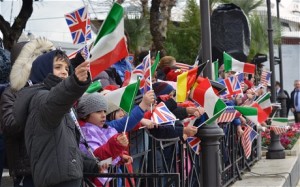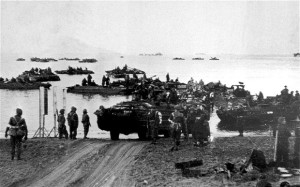British veterans commemorate 70th anniversary of Anzio landings in Italy
Daily News Article — Posted on January 24, 2014
(by Nick Squires, London’s Daily Telegraph) ANZIO – A group of British veterans took part in events to commemorate the 70th anniversary of the Anzio landings in Italy on Wednesday.

The four British veterans were treated as guests of honor by the town of Anzio, with local dignitaries giving speeches, schoolchildren waving Union Jacks and Italian soldiers and sailors providing an honor guard.
Just four veterans traveled to the coastal town south of Rome to remember one of the most savage campaigns of the Second World War, sometimes known as “the forgotten D-Day.”
The youngest veteran is 88 while the oldest is 91. The small number of former servicemen taking part in the anniversary is testimony to the dwindling number of survivors from the campaign.
Alex Munro served in the Scottish Horse, William Gerrie was a member of the Royal Signals and Jack Hearn was in the Royal Army Service Corps.
The only non-Army member of the group is Stan Turton, who served aboard HMS Spartan, a Royal Navy cruiser that took part in the landings on Jan. 22, 1944 but was bombed and sunk a week later.
Operation Shingle, as the campaign was known, was an attempt to outflank the Germans’ Gustav Line of defense further south, where Allied forces were struggling to break through.
Tens of thousands of Allied troops landed at Anzio and the nearby town of Nettuno, establishing a precarious bridgehead that came under constant attack from the Germans.

Amphibious landing craft loaded with British infantry coming ashore near Anzio, Italy, in 1944
The landings initially took the Germans by surprise but within days they mobilized a massive counter-attack.
An unusually cold winter produced miserable conditions for both sides, with many soldiers drawing comparisons with the trench warfare of the First World War.
“So we go back to World War One,” wrote one officer from a Scottish regiment. “Oozing thick mud. Tank hulks. The cold, God, the cold.”
After months of desperate fighting, in which the opposing sides lived “like nocturnal animals”, according to one soldier’s diary, the Allies managed to break out of the beach head and liberate Rome on June 4.
“Everyone remembers the D-Day landings in Normandy but in Italy we went through three D-days – Sicily, Salerno and Anzio,” Harry Shindler, who was attached as an engineer to the Sherwood Foresters, told The Daily Telegraph at the 65th anniversary of the landings.
“We had a very bad time of it. The Germans could see every inch of the beachhead so you had to moved around very quickly, if you moved at all. We lived underground in foxholes.”
The Allies suffered 43,000 casualties, of whom 7,000 died and 36,000 were wounded or missing. The Germans suffered similar losses.
Reprinted here for educational purposes only. From a Telegraph news report, with excerpts added from the Daily Mail article. May not be reproduced on other websites without permission from the Daily Telegraph.
Questions
1. a) Who were the Allies of WWII? Be specific.
b) What were the group of countries fighting the Allies called?
c) Where is Anzio?
d) When did the landings at Anzio take place?
2. How many British veterans attended the 70th commemoration of the landing at Anzio?
3. What was Operation Shingle? - how long did it last?
4. a) How many Allied troops initially landed at Anzio for Operation Shingle?
b) How many Allied troops were killed/injured as a result of Operation Shingle?
5. As of this post, we were able to find only one news video on the commemoration (from Reuters), posted by only a few media outlets, without any accompanying article.
a) Why do you think news organizations did not find the 70th anniversary of Anzio, with some of the last living veterans in attendance newsworthy?
b) Why is it important for the media to provide this news to the public?
Background
From an additional Telegraph article "Veterans remember the Anzio landings that liberated Rome"
In the early hours of Jan 22, 1944, an initial wave of 36,000 British and American troops landed on X-Ray beach and Peter beach, in front of the towns of Anzio and Nettuno.
They initially encountered only light resistance, but within days the Germans had rushed fresh divisions from France and Yugoslavia into the area, launching vigorous counter-attacks and threatening to push the Allies back into the sea.
"The entire beach head was in range of German artillery, so you had to keep your head down," said William Gerrie, 92, who served with the Royal Corps of Signals. "It was frightening but you just had to put up with it. You dug a big hole and lived in it for months," said Mr. Gerrie.
An extremely cold winter made conditions miserable for both sides, with soldiers drawing parallels with the trench warfare of the First World War. British units "suffered to the limit of human endurance," according to one official war report.
"What followed [after the landings] was five months of hard fighting that mirrored the bitterness of the First World War: a stalemate of cold, wet trench warfare, fought at close range, artillery ensuring a struggle for survival whether in the front line or further back," Christopher Prentice, the British ambassador to Italy, said during a remembrance service.
"Today we remember their courage and sacrifice, of the contribution they made to the liberation of Italy and the defeat of the scourge of Nazism, these ordinary young men."
Alex Munro, 91, who served as a forward observation officer with the Scottish Horse, an artillery regiment, said: "We lived in dug-outs, right up on the front line. We made little holes in the walls where we put our mess tins and things. You could hear the Germans in the opposing trenches. Conditions were OK during the day, but at night the big guns fired," said Mr. Munro.
The devastation wrought by German artillery meant that some remains were never found, and the graves of those soldiers are marked simply: "A soldier of the 1939-1945 war, known unto God." The Germans' most fearsome weapons were two giant artillery pieces mounted on train under-carriages which lobbed huge shells onto the Allied forces.
They were nicknamed "the Anzio Express" and "Anzio Annie" by the British and American troops.
After months of desperate fighting, the Allies managed to break out of the beach head, drive north and liberate Rome on June 4.
Two days later the world's attention turned to the Normandy landings.
